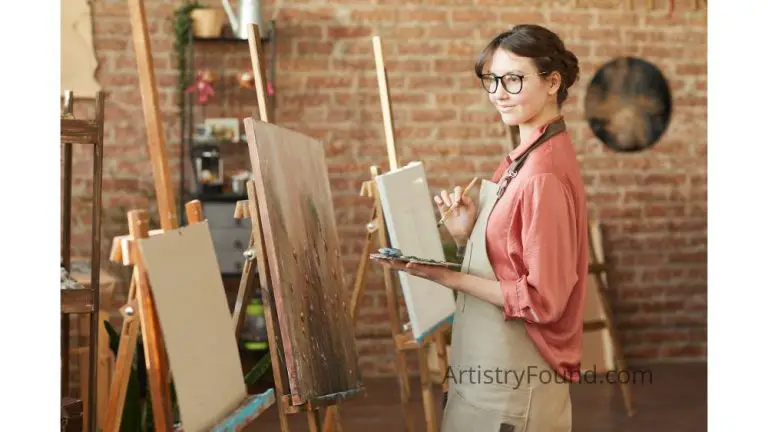How Artists See The World (A Different Vision)
There’s a general belief that artists see the world through a completely different set of eyes from other people. Where a non-artist might see a cracked and broken sidewalk, an artist might be captivated by a small flower growing between one of the cracks. Why do some people see one thing, while an artist can view the same scene from an entirely different perspective? Let’s explore how artists see the world.
Artists are intent observers of the world around them and see through a lens of “feeling”. Artists consciously use their minds in everyday life to search out visual cues that create an emotional response within them. The art they create and share is their interpretation of that emotional response.
Because great art comes from an emotional place, not every artist sees the world in the same way. But why is that? Is it because of the individual artist, their medium (drawing, painting, sculpture, photography, etc.), creative process, or something else?
Well, as it turns out, it’s not so easy to pinpoint the reasons why each artist sees the world through a different lens. However, we can look towards a few commonalities that drive those different worldviews.
In this article, we will explore a few reasons that affect how an artist sees the world. In doing so, perhaps we can understand artists, their artwork, and even the world around us just a little bit better.
Let’s get started.

(This article may contain affiliate links and I may earn a commission if you make a purchase)
Artists Are ‘Creatives’
First and foremost, we must understand that artists view themselves as ‘creatives’. It could be argued that this label and unique sense of identity form a foundation for how an artist develops their worldview. Not only do they want to observe and experience the world, but they must also create something out of it to share with others.
By identifying as a creative person, an artist is already seeking inspiration by default, whether they realise this or not. Their minds are tuned towards things, people, and situations that they can channel towards their artwork.
For example, a visual artist like a painter or graphic designer will subconsciously look for visual forms of inspiration to incorporate in their painting and design work. That may include scenery, shapes, colors, and so much more. On the other hand, a photographer may see the world in terms of movement and the unique motion that different subjects will exhibit.
But being a ‘creative’ isn’t just about observing, it’s also about ‘creating’. Artists observe the world, while at the same time thinking of capturing what they see and expressing it artistically, whether on canvas, in a photograph, or whatever their chosen medium might be. Artists operate in a world of conscious perception.
Simply put, creative people see the world as a passive observer and capture and express their observations through their art.
An Artist’s Creative Interpretation
Still, artists don’t just see the world and accept it at face value. On the contrary, the artwork is always shaded, literally or figuratively, by the artist’s interpretations of what they’ve observed.
Remember: the artist sits between the observation and the artwork, which means that everything is filtered through their unique individual perspective. Those perspectives come from the artist, their upbringing, extraordinary life experiences, creativity, and personalities.
For instance, a sad artist will interpret the world they see in a much different light than those who see things from a more positive perspective. Others may focus on aspects of the world that resonate deeply with their pain, sorrows, or even their regrets.
Artists Have A Different Vision; Literally
With all that said, it’s also important to understand that artists don’t just see the world differently in an abstract sense. Plenty of scientific studies have shown that the eyes and brains of an artist literally capture and interpret their observations in ways that are very different from other people.
Let’s continue the earlier example of visual artists. These kinds of artists tend to be exceptionally sensitive towards the visual aspects of anything they look at. They’ll be the first to notice the subtle nuances of the colors and shapes involved, not to mention the lighting.
For some artists, their unique way of seeing the world is quite literal. Some of the world’s most famous visual artists suffered from all kinds of visual abnormalities like stereoblindness, color blindness, and more. These literal differences in perspectives influenced their visual perception and the artwork that they produced, as their way of showing the world how they see through their own eyes.
But that’s just one type of artist and their unique way of taking in the world. Other types of creatives also have nuanced senses, though theirs will depend on their chosen medium.
For example, a musician will have well-trained ears to focus more on the sounds that they hear in the world around them. A writer may rely on their understanding of people to focus on the story behind the subject that they’re observing.
At the end of the day, the way that an artist sees the world also depends on the medium that they’ll use to express it, and that will tune their senses accordingly.
Artists Catch What Others Miss
Despite the differences in how they see the world and the mediums they use to express it, artists and their worldviews all have one thing in common. What is it?
Well, artists are exceptionally talented at catching what others miss.
As human beings, our minds naturally focus only on things that are of immediate importance to us. Most of us don’t realise just how much our minds filter out as we walk through the world every single day.
Artists, on the other hand, are always on the lookout. With their eyes and ears, they’re always picking up on subtle things that others may not notice. In a world where others are moving quicker and staying busier, artists are calm observers watching everything else go by.
How Art Helps Others
Why does it matter how artists see the world? Well, the answers to that question are also the same reasons why art and the art world is so valuable in the first place.
By observing, interpreting, and expressing how they see the world, artists offer valuable lessons to those who don’t know the world the same way.
You see, most people are so used to experiencing the world in the same way they always have. Through art, people can discover and adopt different perspectives and see the same world in ways they’ve never thought of before.
An artist’s unique perspective can also provide hope to many. That’s especially true for people who feel alone until they discover an artist who shares the same worldview.
With all of that considered, that old famous saying seems truer now more than ever: the actual value of art is in how it makes you feel.
More From Artistry Found:
- Does A Self-Portrait Have To Be Of You? (Or Your Face)
- Artists vs Scientists (Similarities & Differences)
Sources:








